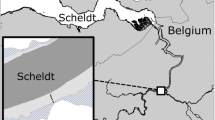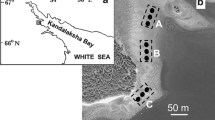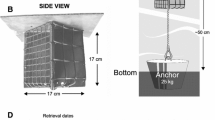Abstract
The hypothesis was tested that predation-disturbance by epibenthic macrofauna affects the abundance of sediment-dwelling harpacticoid copepods. The copepods inhabited a subtidal seagrass (Zostera marina L.) bed in British Columbia, Canada. The response of the harpacticoid community was observed in controlled field experiments in which epibenthic predators-disturbers were excluded from portions of the seagrass bed. Controlled, exclusion-cage (0.8 m2 area, 7-mm mesh) experiments were conducted within the seagrass bed from late March/early April to mid-June in both 1986 and 1987. Sampling was conducted biweekly. Exclusion of large epibenthic predators-disturbers had little effect on sediment-dwelling harpacticoid copepod density. Total harpacticoid numbers and abundances of dominant species generally did not increase in the exclusion treatment relative to the control. Shifts in species composition of the harpacticoid community did not occur. The treatment control was adequate in simulating the exclusion cage structure. It appears that large epibenthic predators-disturbers have little impact on the abundance of harpacticoid copepod populations at this study site.
Similar content being viewed by others
Literature cited
Alheit, J., Scheibel, W. (1982). Benthic harpacticoids as a food source for fish. Mar. Biol. 70: 141–147
Bell, J. D., Westoby, M. (1986). Abundance of macrofauna in dense seagrass is due to habitat preference, not predation. Oecologia 68: 205–209
Bell, S. S. (1980). Meiofauna-macrofauna interactions in a high salt marsh habitat. Ecol. Monogr. 50: 487–505
Bell, S. S., Woodin, S. A. (1984). Community unity: experimental evidence for meiofauna and macrofauna. J. mar. Res. 42: 605–632
Chandler, G. T., Fleeger, J. W. (1983). Meiofaunal colonization of azoic estuarine sediment in Louisiana: mechanisms of dispersal. J. exp. mar. Biol. Ecol. 69: 175–188
Coen, L. D., Heck, K. L., Jr., Abele, L. G. (1981). Experiments on competition and predation among shrimps of seagrass meadows. Ecology 62: 1484–1493
D'Amours, D. (1987). Trophic phasing of juvenile chum salmonOncorhynchus keta Walbaum and harpacticoid copepods in the Fraser River Estuary, British Columbia. Ph.D. thesis, University of British Columbia, Vancouver
Eckman, J. E. (1987). The role of hydrodynamics in recruitment, growth, and survival ofArgopecten irradians (L.) andAnomia simplex (D'Orbigny) within eelgrass meadows. J. exp. mar. Biol. Ecol. 106: 165–191
Ellis, M. J., Coull, B. C. (1989). Fish predation on meiobenthos: field experiments with juvenile spotLeiostomus xanthurus Lacepede. J. exp. mar. Biol. Ecol. 130: 19–32
Fitzhugh, G. R., Fleeger, J. W. (1985). Goby (Pisces: Gobiidae) interactions with meiofauna and small macrofauna. Bull. mar. Sci. 36: 436–444
Fleeger, J. W. (1985). Small benthos in estuarine food webs: comparing intertidal and subtidal habitats. In: Bryan, C. F., Zwank, P. J., Chabrek, R. H. (eds.) Proceedings of the fourth coastal marsh and estuary management symposium. Louisiana State University, Baton Rouge, p. 127–141
Fleeger, J. W., Whipple, S. A., Cook, L. L. (1982). Field manipulations of tidal flushing, light exposure and natant macrofauna in a Louisiana salt marsh: effect on the meiofauna. J. exp. mar. Biol. Ecol. 56: 87–100
Gee, J. M. (1989). An ecological and economic review of meiofauna as food for fish. Zool. J. Linn. Soc. 96: 243–261
Gee, J. M., Warwick, R. M., Davey, J. T., George, C. L. (1985). Field experiments on the role of epibenthic predators in determining prey densities in an estuarine mudflat. Estuar. cstl Shelf Sci. 21: 429–448
Gordon, D. K., Levings, C. D. (1984). Seasonal changes of inshore fish populations on Sturgeon and Roberts Bank, Fraser River estuary, British Columbia. Can. Tech. Rep. Fish. aquat. Sciences, Canada 1240: 1–81
Harrison, B. J. (1981). The biological determinants of the structure of harpacticoid copepod communities on an estuarine intertidal flat. Ph.D. thesis, University of British Columbia, Vancouver
Harrison, P. G. (1987). Natural expansion and experimental manipulation of seagrass (Zostera spp.) abundance and the response of infaunal invertebrates. Estuar. cstl Shelf Sci. 24: 799–812
Hicks, G. R. F. (1984). Spatio-temporal dynamics of a meiobenthic copepod and the impact of predation-disturbance. J. exp. mar. Biol. Ecol. 81: 47–72
Hicks, G. R. F., Coull, B. C. (1983). The ecology of marine meiobenthic harpacticoid copepods. Oceanogr. mar. Biol. A. Rev. 21: 67–175
Hulberg, L. W., Oliver, J. S. (1980). Caging manipulations in marine soft-bottom communities: importance of animal interactions or sedimentary habitat modifications. Can. J. Fish. aquat. Sciences 37: 1130–1139
Hunt, J. H., Ambrose, W. G., Jr., Peterson, C. H. (1987). Effects of the gastropodIlyanassa obsoleta (Say), and the bivalve,Mercenaria mercenaria (L.), on larval settlement and juvenile recruitment of infauna. J. exp. mar. Biol. Ecol. 108: 229–240
Hurlbert, S. H. (1984). Pseudoreplication and the design of ecological field experiments. Ecol. Monogr. 54: 187–211
Jensen, K. T., Jensen, J. N. (1985). The importance of some epibenthic predators on the density of juvenile benthic macrofauna in the Danish Wadden Sea. J. exp. mar. Biol. Ecol. 89: 157–174
Johnston, N. T., Lasenby, D. C. (1982). Diet and feeding ofNeomysis mercedis Holmes (Crustacea, Mysidacea) from the Fraser River estuary, British Columbia. Can. J. Zool. 60: 813–824
Lafontaine, Y. de, Leggett, W. C. (1987). Effect of container size on estimates of mortality and predation rates in experiments with macrozooplankton and larval fish. Can. J. Fish. aquat. Sciences 44: 1534–1543
Leber, K. M. (1985). The influence of predatory decapods, refuge, and microhabitat selection on seagrass communities. Ecology 66: 1951–1964
Nelson, W. G. (1979). Experimental studies of selective predation on amphipods: consequences for amphipod distribution and abundance. J. exp. mar. Biol. Ecol. 38: 225–245
Nowell, A. R. M., Jumars, P. A. (1984). Flow environments of aquatic benthos. A. Rev. Ecol. Syst. 15: 303–328
Orth, R. J., Heck, K. L., Jr., Van Montfrans, J. (1984). Faunal communities in seagrass beds: a review of the influence of plant structure and prey characteristics on predator-prey relationships. Estuaries 7: 339–350
Peterson, C. H. (1982). Clam predation by whelks (Busycon spp.): experimental tests of the importance of prey size, prey density, and seagrass cover. Mar. Biol. 66: 159–170
Peterson, C. H. (1986). Enhancement ofMercenaria mercenaria densities in seagrass beds: is pattern fixed during settlement season or altered by subsequent differential survival? Limnol. Oceanogr. 31: 200–205
Sherman, K. M., Coull, B. C. (1980). The response of meiofauna to sediment disturbance. J. exp. mar. Biol. Ecol. 46: 59–71
Stoner, A. W. (1982). The influence of benthic macrophytes on the foraging behavior of pinfish,Lagodon rhomboides (Linnaeus). J. exp. mar. Biol. Ecol. 58: 271–284
Summerson, H. C., Peterson, C. H. (1984). Role of predation in organizing benthic communities of a temperature-zone seagrass bed. Mar. Ecol. Prog. Ser. 15: 63–77
Swinbanks, D. D., Luternauer, J. L. (1987). Burrow distribution of Thalassinidean shrimp on a Fraser delta tidal flat, British Columbia. J. Paleont. 61: 315–332
Thistle, D. (1980). The response of a harpacticoid copepod community to a small-scale natural disturbance. J. mar. Res. 38: 381–395
Virnstein, R. W. (1977). The importance of predation by crabs and fishes on benthic infauna in Chesapeake Bay. Ecology 58: 1199–1217
Virnstein, R. W. (1978) Predator caging experiments in soft sediments: caution advised. In: Wiley, M. L. (ed.) Estuarine interactions. Academic Press, New York, p. 261–273
Walters, K. (1988). Diel vertical migration of sediment-associated meiofauna in subtropical sand and seagrass habitats. J. exp. mar. Biol. Ecol. 117: 169–186
Webb, D. G. (1989). Predation by juvenile salmonids on harpacticoid copepods in a shallow subtidal seagrass bed: effects on copepod community structure and dynamics. Ph.D. Thesis, University of British Columbia, Vancouver
Wilkinson, L. (1985). SYSTAT. The system for statistics, version 2.1. Systat, Inc., Evanston, Illinois
Wilson, K. A., Heck, K. L., Jr., Able, K. W. (1987). Juvenile blue crab,Callinectes sapidus, survival: an evaluation of eelgrass,Zostera marina, as refuge. Fish. Bull. U.S. 85: 53–58
Author information
Authors and Affiliations
Additional information
Communicated by R. O'Dor, Halifax
Rights and permissions
About this article
Cite this article
Webb, D.G., Parsons, T.R. Impact of predation-disturbance by large epifauna on sediment-dwelling harpacticoid copepods: Field experiments in a subtidal seagrass bed. Mar. Biol. 109, 485–491 (1991). https://doi.org/10.1007/BF01313514
Accepted:
Issue Date:
DOI: https://doi.org/10.1007/BF01313514




